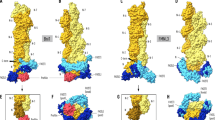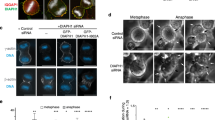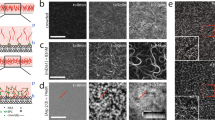Abstract
Humans express 15 formins that play crucial roles in actin-based processes, including cytokinesis, cell motility and mechanotransduction1,2. However, the lack of structures bound to the actin filament (F-actin) has been a major impediment to understanding formin function. Whereas formins are known for their ability to nucleate and elongate F-actin3,4,5,6,7, some formins can additionally depolymerize, sever or bundle F-actin. Two mammalian formins, inverted formin 2 (INF2) and diaphanous 1 (DIA1, encoded by DIAPH1), exemplify this diversity. INF2 shows potent severing activity but elongates weakly8,9,10,11 whereas DIA1 has potent elongation activity but does not sever4,8. Using cryo-electron microscopy (cryo-EM) we show five structural states of INF2 and two of DIA1 bound to the middle and barbed end of F-actin. INF2 and DIA1 bind differently to these sites, consistent with their distinct activities. The formin-homology 2 and Wiskott–Aldrich syndrome protein-homology 2 (FH2 and WH2, respectively) domains of INF2 are positioned to sever F-actin, whereas DIA1 appears unsuited for severing. These structures also show how profilin-actin is delivered to the fast-growing barbed end, and how this is followed by a transition of the incoming monomer into the F-actin conformation and the release of profilin. Combined, the seven structures presented here provide step-by-step visualization of the mechanisms of F-actin severing and elongation by formins.
This is a preview of subscription content, access via your institution
Access options
Access Nature and 54 other Nature Portfolio journals
Get Nature+, our best-value online-access subscription
$32.99 / 30 days
cancel any time
Subscribe to this journal
Receive 51 print issues and online access
$199.00 per year
only $3.90 per issue
Buy this article
- Purchase on SpringerLink
- Instant access to full article PDF
Prices may be subject to local taxes which are calculated during checkout



Similar content being viewed by others
Data availability
Molecular models and cryo-EM density maps have been deposited with the following accession codes: INF2 middle up (PDB code 9B03; EMDB codes EMD-44026, EMD-44020, EMD-44022, EMD-44023, EMD-44024, EMD-44025, EMD-44948); INF2 middle down (PDB code 9B0K; EMDB codes EMD-44045, EMD-44027, EMD-44030, EMD-44031, EMD-44032, EMD-44033, EMD-44943); DIA1 middle (PDB code 9B3D; EMDB codes EMD-44135); INF2 barbed end (PDB code 9AZ4; EMDB codes EMD-44012, EMD-44009, EMD-44010, EMD-44011, EMD-44950, EMD-44951); DIA1 barbed end (PDB code 9B27; EMDB code EMD-44099); INF2 with incoming profilin-actin (PDB code 9AZP; EMDB codes EMD-44018, EMD-44956, EMD-44958); INF2 with incoming actin (PDB code 9AZQ; EMDB codes EMD-44019, EMD-44973, EMD-44972); previously published structures used in model building (PDB codes 2PAV and 8F8P).
References
Breitsprecher, D. & Goode, B. L. Formins at a glance. J. Cell Sci. 126, 1–7 (2013).
Valencia, D. A. & Quinlan, M. E. Formins. Curr. Biol. 31, R517–R522 (2021).
Romero, S. et al. Formin is a processive motor that requires profilin to accelerate actin assembly and associated ATP hydrolysis. Cell 119, 419–429 (2004).
Kovar, D. R., Harris, E. S., Mahaffy, R., Higgs, H. N. & Pollard, T. D. Control of the assembly of ATP- and ADP-actin by formins and profilin. Cell 124, 423–435 (2006).
Otomo, T. et al. Structural basis of actin filament nucleation and processive capping by a formin homology 2 domain. Nature 433, 488–494 (2005).
Paul, A. S. & Pollard, T. D. Review of the mechanism of processive actin filament elongation by formins. Cell Motil. Cytoskeleton 66, 606–617 (2009).
Thompson, M. E., Heimsath, E. G., Gauvin, T. J., Higgs, H. N. & Kull, F. J. FMNL3 FH2-actin structure gives insight into formin-mediated actin nucleation and elongation. Nat. Struct. Mol. Biol. 20, 111–118 (2013).
Chhabra, E. S. & Higgs, H. N. INF2 Is a WASP homology 2 motif-containing formin that severs actin filaments and accelerates both polymerization and depolymerization. J. Biol. Chem. 281, 26754–26767 (2006).
Gurel, P. S. et al. INF2-mediated severing through actin filament encirclement and disruption. Curr. Biol. 24, 156–164 (2014).
Gurel, P. S. et al. Assembly and turnover of short actin filaments by the formin INF2 and profilin. J. Biol. Chem. 290, 22494–22506 (2015).
Korobova, F., Ramabhadran, V. & Higgs, H. N. An actin-dependent step in mitochondrial fission mediated by the ER-associated formin INF2. Science 339, 464–467 (2013).
Higgs, H. N. Formin proteins: a domain-based approach. Trends Biochem. Sci. 30, 342–353 (2005).
Zimmermann, D. & Kovar, D. R. Feeling the force: formin’s role in mechanotransduction. Curr. Opin. Cell Biol. 56, 130–140 (2019).
Labat-de-Hoz, L. & Alonso, M. A. Formins in human disease. Cells 10, 2554 (2021).
Mullins, R. D., Bieling, P. & Fletcher, D. A. From solution to surface to filament: actin flux into branched networks. Biophys. Rev. 10, 1537–1551 (2018).
Xu, Y. et al. Crystal structures of a Formin Homology-2 domain reveal a tethered dimer architecture. Cell 116, 711–723 (2004).
Zigmond, S. H. et al. Formin leaky cap allows elongation in the presence of tight capping proteins. Curr. Biol. 13, 1820–1823 (2003).
Kovar, D. R., Kuhn, J. R., Tichy, A. L. & Pollard, T. D. The fission yeast cytokinesis formin Cdc12p is a barbed end actin filament capping protein gated by profilin. J. Cell Biol. 161, 875–887 (2003).
Gould, C. J. et al. The formin DAD domain plays dual roles in autoinhibition and actin nucleation. Curr. Biol. 21, 384–390 (2011).
Quinlan, M. E., Hilgert, S., Bedrossian, A., Mullins, R. D. & Kerkhoff, E. Regulatory interactions between two actin nucleators, Spire and Cappuccino. J. Cell Biol. 179, 117–128 (2007).
Breitsprecher, D. et al. Rocket launcher mechanism of collaborative actin assembly defined by single-molecule imaging. Science 336, 1164–1168 (2012).
Yamana, N. et al. The Rho-mDia1 pathway regulates cell polarity and focal adhesion turnover in migrating cells through mobilizing Apc and c-Src. Mol. Cell. Biol. 26, 6844–6858 (2006).
Brandt, D. T. et al. Dia1 and IQGAP1 interact in cell migration and phagocytic cup formation. J. Cell Biol. 178, 193–200 (2007).
Fessenden, T. B. et al. Dia1-dependent adhesions are required by epithelial tissues to initiate invasion. J. Cell Biol. 217, 1485–1502 (2018).
Brown, E. J. et al. Mutations in the formin gene INF2 cause focal segmental glomerulosclerosis. Nat. Genet. 42, 72–76 (2010).
Boyer, O. et al. INF2 mutations in Charcot-Marie-Tooth disease with glomerulopathy. N. Engl. J. Med. 365, 2377–2388 (2011).
Ueyama, T. et al. Constitutive activation of DIA1 (DIAPH1) via C-terminal truncation causes human sensorineural hearing loss. EMBO Mol. Med. 8, 1310–1324 (2016).
Jumper, J. et al. Highly accurate protein structure prediction with AlphaFold. Nature 596, 583–589 (2021).
Carman, P. J., Barrie, K. R., Rebowski, G. & Dominguez, R. Structures of the free and capped ends of the actin filament. Science 380, eadg6812 (2023).
Jaiswal, R. et al. The formin Daam1 and fascin directly collaborate to promote filopodia formation. Curr. Biol. 23, 1373–1379 (2013).
Bombardier, J. P. et al. Single-molecule visualization of a formin-capping protein ‘decision complex’ at the actin filament barbed end. Nat. Commun. 6, 8707 (2015).
Harris, E. S., Rouiller, I., Hanein, D. & Higgs, H. N. Mechanistic differences in actin bundling activity of two mammalian formins, FRL1 and mDia2. J. Biol. Chem. 281, 14383–14392 (2006).
Scott, B. J., Neidt, E. M. & Kovar, D. R. The functionally distinct fission yeast formins have specific actin-assembly properties. Mol. Biol. Cell 22, 3826–3839 (2011).
Ramabhadran, V., Gurel, P. S. & Higgs, H. N. Mutations to the formin homology 2 domain of INF2 protein have unexpected effects on actin polymerization and severing. J. Biol. Chem. 287, 34234–34245 (2012).
Maufront, J. et al. Direct observation of the conformational states of formin mDia1 at actin filament barbed ends and along the filament. Mol. Biol. Cell 34, ar2 (2023).
Chereau, D. et al. Actin-bound structures of Wiskott-Aldrich syndrome protein (WASP)-homology domain 2 and the implications for filament assembly. Proc. Natl Acad. Sci. USA 102, 16644–16649 (2005).
Dominguez, R. The WH2 domain and actin nucleation: necessary but insufficient. Trends Biochem. Sci 41, 478–490 (2016).
Zsolnay, V., Katkar, H. H., Chou, S. Z., Pollard, T. D. & Voth, G. A. Structural basis for polarized elongation of actin filaments. Proc. Natl Acad. Sci. USA 117, 30458–30464 (2020).
Oda, T., Iwasa, M., Aihara, T., Maeda, Y. & Narita, A. The nature of the globular- to fibrous-actin transition. Nature 457, 441–445 (2009).
Pollard, T. D. Actin and actin-binding proteins. Cold Spring Harb. Perspect Biol. https://doi.org/10.1101/cshperspect.a018226 (2016).
Oosterheert, W. et al. Molecular mechanism of actin filament elongation by formins. Science 384, eadn9560 (2024).
Ferron, F., Rebowski, G., Lee, S. H. & Dominguez, R. Structural basis for the recruitment of profilin-actin complexes during filament elongation by Ena/VASP. EMBO J. 26, 4597–4606 (2007).
Punjani, A., Rubinstein, J. L., Fleet, D. J. & Brubaker, M. A. cryoSPARC: algorithms for rapid unsupervised cryo-EM structure determination. Nat. Methods 14, 290–296 (2017).
Zheng, S. Q. et al. MotionCor2: anisotropic correction of beam-induced motion for improved cryo-electron microscopy. Nat. Methods 14, 331–332 (2017).
Bepler, T. et al. Positive-unlabeled convolutional neural networks for particle picking in cryo-electron micrographs. Nat. Methods 16, 1153–1160 (2019).
Naydenova, K. & Russo, C. J. Measuring the effects of particle orientation to improve the efficiency of electron cryomicroscopy. Nat. Commun. 8, 629 (2017).
Casanal, A., Lohkamp, B. & Emsley, P. Current developments in Coot for macromolecular model building of electron cryo-microscopy and crystallographic data. Protein Sci. 29, 1069–1078 (2020).
van Zundert, G. C. P., Moriarty, N. W., Sobolev, O. V., Adams, P. D. & Borrelli, K. W. Macromolecular refinement of X-ray and cryoelectron microscopy structures with Phenix/OPLS3e for improved structure and ligand quality. Structure 29, 913–921 (2021).
Pettersen, E. F. et al. UCSF ChimeraX: structure visualization for researchers, educators, and developers. Protein Sci. 30, 70–82 (2021).
Acknowledgements
We thank H. Higgs for providing the INF2 and Diaph1 genes and for valuable discussions. This study was supported by National Institutes of Health grant nos. R01 GM073791 and RM1 GM136511 to R.D. and T32 AR053461 to N.J.P. Data collection was supported by the Electron Microscopy Resource Lab and The Beckman Center for Cryo-Electron Microscopy, University of Pennsylvania (Research Resource Identifier SCR_022375) and the National Center for CryoEM Access and Training through National Institutes of Health grant no. U24 GM129539.
Author information
Authors and Affiliations
Contributions
N.J.P., K.R.B. and R.D. conceived and designed the study. N.J.P. performed sample preparation and cryo-EM data collection. N.J.P. and K.R.B. processed the cryo-EM data and generated three-dimensional reconstructions. N.J.P., K.R.B. and R.D. conducted structural analyses and interpretations. N.J.P., K.R.B. and R.D. prepared figures and videos. R.D. wrote the initial draft, acquired funding and supervised the work. N.J.P., K.R.B. and R.D. edited the final manuscript.
Corresponding author
Ethics declarations
Competing interests
The authors declare no competing interests.
Peer review
Peer review information
Nature thanks Edward Egelman and Thomas Pollard for their contribution to the peer review of this work. Peer reviewer reports are available.
Additional information
Publisher’s note Springer Nature remains neutral with regard to jurisdictional claims in published maps and institutional affiliations.
Extended data figures and tables
Extended Data Fig. 1 Definitions and nomenclatures used.
(a) Domain diagrams of INF2 and Dia1, with zooms defining sub-domains within the FH2 domain. (b) The FH2 dimer forms a ring-like structure mediated by head-to-tail lasso-post interactions (left). FH2 subdomains colored as in part a (right). The newly-defined HCBH is highlighted in red. (c) Actin filament (PDB code: 8F8P) indicating short and long-pitch helices, pointed and barbed ends, plug, H-cleft, and D-loop. (d) Two perpendicular views of the actin monomer (PDB code: 1J6Z) with subdomains 1–4 labeled in blue circles. The H-cleft, nucleotide cleft, D-loop, and plug are indicated. (e) G- (blue, twisted) to F-actin (gray, flat) conformational transition, characterized by a 20° rotation of subdomains 1 and 2 relative to 3 and 4.
Extended Data Fig. 2 Cryo-EM maps around FH2 and HCBH.
(a-g) FH2 fit to the cryo-EM maps for the seven structures described here (as indicated). (h) HCBH of the mobile FH2 of INF2 fit to the cryo-EM map in the up and down mid-filament-bound states.
Extended Data Fig. 3 F-actin-FH2 contact surface areas.
(a-g) For each interaction, the contact area in F-actin is colored according to the interacting FH2. On the FH2 side, contact areas are colored cyan, marine blue, blue, and white depending on which actin subunit it contacts. Contact surface areas (given for each interaction in black boxes) were calculated using the server GetArea (https://curie.utmb.edu/getarea.html).
Extended Data Fig. 4 Comparisons between INF2 and Dia1.
(a) Sequence alignment of WASP WH2 (UniProt code: P42768) with the WH2s of INF2 and Dia1. Note the absence of the LKKT motif in Dia1. (b) Superimposition of AlphaFold models of the FH2-WH2 regions of INF2 (632–991) and Dia1 (833–1200), highlighting differences in the length of the antennas and WH2-FH2 linkers. (c-d) Comparisons of the positions of the FH2s of INF2 (magenta) and Dia1 (orange) bound to A5 and A6 at the barbed end. The comparison is based on a superimposition of the corresponding actin subunits in the two structures.
Extended Data Fig. 5 Long-pitch interactions.
(a-c) Long-pitch interactions and corresponding cryo-EM maps of subdomain 2 in F-actin (a), incoming profilin-actin (b) and incoming actin (c). In all the structures, the D-loop inserts into the H-cleft of the subunit above. However, for the incoming monomer (blue), subdomain 4 contacts subdomain 3 of A5 only after a 14° rotation and the G- to F-actin transition (see also Fig. 3e,f in the main text).
Supplementary information
Supplementary Information
Supplementary Figs. 1–14.
Supplementary Video 1
Structures of INF2 and Dia1 in the middle of F-actin. Comparison of the structures of INF2 and Dia1 bound in the middle of F-actin, highlighting differences in position between the up and down states of INF2 with Dia1 in the middle.
Supplementary Video 2
Proposed hand-over-hand mechanism of F-actin severing by INF2. The video shows cryo-EM maps and models of proposed steps of the severing mechanism (see also Fig. 2 in main text).
Supplementary Video 3
Structures of INF2 and Dia1 at the barbed end. Comparison of the structures of INF2 and Dia1 at the barbed end, highlighting differences in position between their FH2s.
Supplementary Video 4
Proposed LERA F-actin elongation mechanism by formins. The video shows cryo-EM maps and models of proposed steps of the elongation mechanism (see also Fig. 3 in main text).
Rights and permissions
Springer Nature or its licensor (e.g. a society or other partner) holds exclusive rights to this article under a publishing agreement with the author(s) or other rightsholder(s); author self-archiving of the accepted manuscript version of this article is solely governed by the terms of such publishing agreement and applicable law.
About this article
Cite this article
Palmer, N.J., Barrie, K.R. & Dominguez, R. Mechanisms of actin filament severing and elongation by formins. Nature 632, 437–442 (2024). https://doi.org/10.1038/s41586-024-07637-0
Received:
Accepted:
Published:
Issue date:
DOI: https://doi.org/10.1038/s41586-024-07637-0
This article is cited by
-
Mechanism of actin filament severing and capping by gelsolin
Nature Structural & Molecular Biology (2025)
-
Regulation of formin INF2 and its alteration in INF2-linked inherited disorders
Cellular and Molecular Life Sciences (2024)



